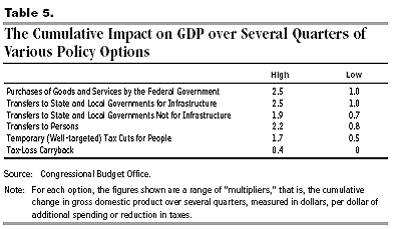This is mostly for my EC102 students. There’s been some argument in the academic economist blogosphere over the size of the fiscal multiplier in the USA. The fiscal multiplier is a measure of by how much GDP rises for an extra dollar of government spending. There are several main forces in determining it’s size:
- The Marginal Propensity to Consume (MPC) determines the upper limit of the multiplier. Suppose that for each extra dollar of income, we tend to spend 60 cents in consumption. Because the economy is a massive, whirling recycling of money – I spend a dollar in your shop, you save 40 cents and spend 60 cents in the second shop, the guy in the second shop pockets 40% of that and spends the rest in the third shop and so on – one dollar of government spending might produce 1+ 0.6 + 0.6^2 + 0.6^3 + … = 1 / (1 – 0.6) = 2.5 dollars of GDP.
- The extra government spending needs to be paid for, which means that taxes will need to go up. For it to be a stimulus now, it’ll typically be financed through borrowing instead of raising taxes now (i.e. taxes will go up later). If people recognise that fact, they may instead choose to consume less and save more in anticipation of that future tax bill, therefore lowering the multiplier. If it gets to a point where there is no difference between raising-taxes-now and borrowing-now-and-raising-taxes-later, we have Ricardian equivalence.
- If the extra government spending is paid for by borrowing, that will raise interest rates (Interest rates and the price of bonds move in opposite directions – by selling more bonds, the government will be increasing their supply and thus lowering their price; hence, the interest rate will rise). If the interest rate goes up, that makes it more expensive for private businesses to borrow, which means that private investment will go down. This is the crowding-out effect. Since GDP = Consumption + Private Investment + Government spending + Net exports, this will lower the multiplier as well.
- The size of the multiplier will also depend on the size of the extra government spending. Generally speaking, the multiplier will be smaller for the second extra dollar spent than for the first and smaller again for the third. That is, increasing government spending exhibits decreasing marginal returns. This is because the second and third points listed above will become more and more relevant for larger and larger amounts of extra government spending.
- Everything gets more complicated when you start to look at current tax rates as well. An alternative to a debt-funded expansion in spending is a debt-funded reduction in revenue (i.e. a tax cut). The multiplier can be very different between those two circumstances.
- Then we have what is arguably the most important part: where the extra spending (or the tax cut) is directed. Poor people have a much higher marginal propensity to consume than rich people, so if you want to increase government spending, you should target the poor to get a larger multiplier. Alternatively, cutting taxes associated with an increase in a business (e.g. payroll taxes) will lower the cost of that increase and produce a larger multiplier than a tax-cut for work that was already happening anyway.
- Next, it is important to note that everything above varies depending on where we are in the business cycle. For example, the crowding-out effect will be strongest (i.e. worst) when the economy is near full employment and be weakest (i.e. less of a problem) when the economy is in recession.
- Finally, we have the progressivity of the tax system. This won’t really affect the size of the multiplier directly, but it is important that you think about it. Rich people pay more tax than poor people, not just in absolute levels (which is obvious), but also as a fraction of their income. That means that the burden of paying back the government debt will fall more on the shoulders of the rich, even after you take into account the fact that they earn more.
Much of what you’ll read arguing for or against a stimulus package will fail to take all of those into account. People are often defending their personal views on the ideal size of government and so tend to pick-and-choose between the various effects in support of their view.
